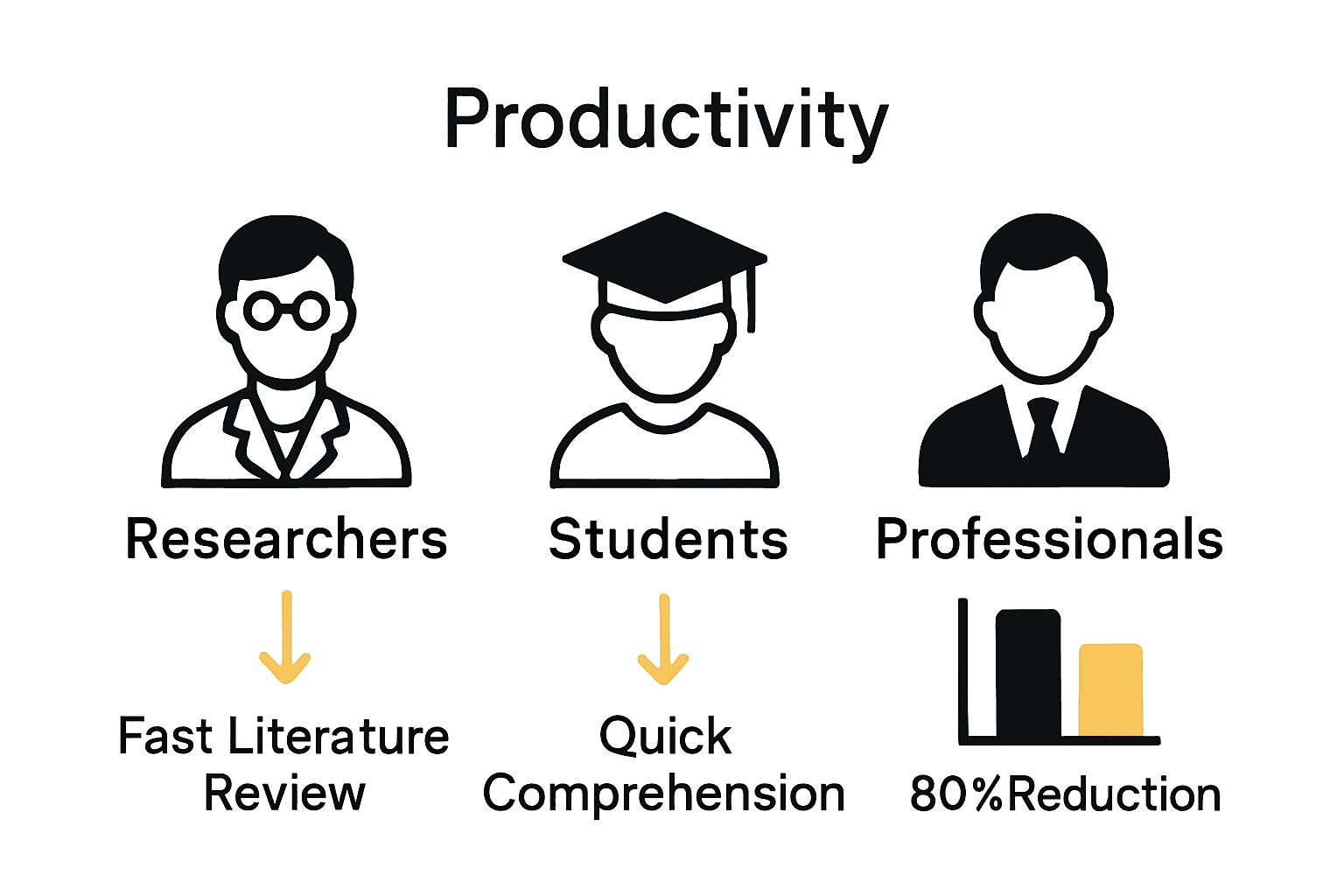Advantages of AI Summarizers: Complete Expert Guide

Did you know that AI summarizers can reduce reading time by up to 80 percent for professionals and students alike? With the explosion of digital information, finding what matters in a sea of text can feel overwhelming. AI summarizers now use advanced language processing to sift through content and highlight the key points, saving time and ensuring nothing important gets lost in the shuffle.
Table of Contents
- Defining AI Summarizers And Core Principles
- Major Types Of AI Summarizers Explained
- How AI Summarizers Process And Deliver Results
- Productivity Benefits For Key User Groups
- Risks, Limitations, And Best Practices
Key Takeaways
| Point | Details |
|---|---|
| AI Summarizers Overview | AI summarizers leverage AI and natural language processing to condense extensive content into meaningful summaries, preserving original context and meaning. |
| Types of Summarization | There are two main types of AI summarization: extractive, which selects sentences directly from the text, and abstractive, which generates new sentences summarizing the content. |
| User Benefits | AI summarizers significantly enhance productivity for researchers, students, and professionals by reducing information processing time and providing quick insights into complex materials. |
| Risks and Best Practices | While effective, AI summarizers can produce inaccuracies, emphasizing the importance of cross-referencing with original materials and treating summaries as starting points for deeper research. |
Defining AI Summarizers and Core Principles
AI summarizers are advanced technological systems that leverage artificial intelligence to transform extensive content into concise, meaningful summaries. According to ijai, these tools utilize natural language processing techniques to analyze and extract essential information while preserving the original context and meaning.
At their core, AI summarizers represent a sophisticated computational approach to data condensation. As en explains, these algorithms specialize in creating subsets of content that represent the most critical information within the original material. This process goes far beyond simple text truncation, involving complex analysis to understand semantic relationships, context, and key themes.
The fundamental principles of AI summarizers include:
- Intelligent content analysis
- Semantic understanding
- Contextual preservation
- Efficient information extraction
- Maintaining original meaning
Modern AI summarizers work through multiple sophisticated stages. They first parse the entire document, identifying key concepts and themes. Then, using advanced machine learning algorithms, they determine the most significant sentences and ideas. The final output is a streamlined summary that captures the essence of the original content without losing critical nuance.
For professionals and learners alike, understanding why choose AI summarizers for efficiency can revolutionize how we consume and process information across various domains.
Major Types of AI Summarizers Explained
AI summarizers are primarily categorized into two distinct approaches: extractive and abstractive summarization. According to ijai, these two types represent fundamentally different strategies for condensing and understanding textual information.
In extractive summarization, the AI system identifies and selects the most important sentences directly from the original text. As en explains, this method involves compiling key sentences that best represent the overall content. Imagine the AI as a careful reader who highlights the most critical passages, creating a summary by stitching together these existing fragments.
Key characteristics of extractive summarization include:
- Direct sentence selection
- Preservation of original wording
- Lower computational complexity
- Minimal language generation
- High fidelity to source material
Abstractive summarization takes a more advanced approach. Instead of simply copying existing sentences, this method generates entirely new text that captures the essence of the original content. Think of it like a skilled translator who doesn’t just translate word-for-word, but conveys the deeper meaning and context.
The primary differences between these approaches are significant. Extractive methods are more straightforward and computationally efficient, while abstractive methods require more sophisticated natural language processing capabilities. When exploring examples of AI summarization tools, you’ll find that many modern systems actually combine elements of both approaches to create more nuanced and accurate summaries.
Here’s a comparison of extractive and abstractive AI summarization approaches:
| Feature | Extractive Summarization | Abstractive Summarization |
|---|---|---|
| Main Method | Selects original sentences | Generates new sentences |
| Language Generation | Minimal | Extensive |
| Fidelity to Source | Very high | Moderate |
| Computational Complexity | Lower | Higher |
| Flexibility | Limited to existing text | Flexible, creative wording |
| Best For | Technical, factual content | Creative, general topics |
How AI Summarizers Process and Deliver Results
The process of generating summaries involves sophisticated computational techniques that go far beyond simple text cutting. According to arxiv, AI summarizers employ advanced methods like Recurrent Neural Networks (RNNs) to analyze text structure and identify the most salient information.
These systems follow a complex multi-stage approach to text processing. As research indicates, the primary stages include initial text parsing, semantic analysis, and information extraction. Sentence importance modeling becomes critical, where the AI evaluates each sentence’s significance based on multiple parameters such as keyword density, position in the document, and contextual relevance.
Key processing techniques involve:
- Semantic network analysis
- Machine learning classification
- Natural language understanding
- Contextual relevance scoring
- Information density evaluation
For handling extensive documents, arxiv suggests a sophisticated divide-and-conquer strategy. This approach segments large texts into smaller, manageable sections, summarizes each segment individually, and then synthesizes these mini-summaries into a comprehensive final output. This method dramatically reduces computational complexity while maintaining summary quality.
When understanding why choose AI summarizers for efficiency, it’s crucial to recognize that these systems are not just about text reduction, but about intelligent information distillation. They transform complex, lengthy content into clear, concise, and meaningful summaries that capture the essence of the original material.
Productivity Benefits for Key User Groups
AI summarizers are transforming productivity across multiple professional and academic domains by dramatically reducing information processing time. According to genieofai, these tools are especially powerful for researchers, enabling quick distillation of complex academic papers into concise, meaningful summaries that accelerate literature review processes.
Students and knowledge workers experience significant productivity gains through AI summarization technologies. As byteplus explains, these tools provide instant insights into lengthy research materials, allowing professionals to extract relevant information rapidly and efficiently. This capability transforms how individuals consume and process complex information across various disciplines.
Productivity benefits vary across different user groups:
- Researchers: Faster literature reviews
- Students: Quicker comprehension of study materials
- Professionals: Rapid information synthesis
- Content creators: Efficient content research
- Journalists: Swift background information gathering
The core advantage of AI summarizers lies in their ability to compress hours of reading into minutes of understanding.

By eliminating redundant information and highlighting critical insights, these tools help users focus on high-value cognitive tasks rather than getting lost in dense textual landscapes.

For those looking to understand why choose AI summarizers for efficiency, the productivity gains are clear: these technologies are not just tools, but intelligent research companions that dramatically streamline information processing across multiple professional and academic domains.
Risks, Limitations, and Best Practices
While AI summarizers offer tremendous potential, they are not without significant challenges. According to arxiv, maintaining accuracy and coherence remains a critical concern, especially when processing complex or nuanced texts. The technology requires careful evaluation and, in many cases, human oversight to verify the generated summaries.
The reliability of AI-generated summaries hinges on sophisticated evaluation mechanisms. As research from arxiv highlights, unsupervised methods may not consistently align with human comprehension. This misalignment underscores the importance of developing robust evaluation metrics and creating feedback loops that continuously improve summary quality.
Key risks and limitations include:
- Potential loss of contextual nuance
- Inaccurate interpretation of complex texts
- Difficulty handling highly specialized language
- Risk of generating misleading summaries
- Inability to capture subtle emotional undertones
Best practices for using AI summarizers effectively involve a critical and discerning approach. Users should always cross-reference summaries with original sources, particularly for academic, legal, or technical documents. Treating AI summaries as starting points for research rather than definitive sources helps mitigate potential inaccuracies.
For those seeking to understand why choose AI summarizers for efficiency, the key is balanced implementation. These tools are powerful assistants, not infallible oracles. Combining AI-generated insights with human critical thinking creates the most reliable and comprehensive understanding of complex information.
Boost Your Learning with AI Summarization Technology
The “Advantages of AI Summarizers: Complete Expert Guide” highlights the challenge of processing lengthy, complex content quickly without losing important context or key insights. This problem is especially relevant for students, researchers, and professionals who need fast, reliable summaries to stay informed and productive. The article emphasizes terms like “semantic understanding,” “contextual preservation,” and “efficient information extraction” which are essential for meaningful summarization.
SummYT transforms these concepts into a practical solution by offering an AI-powered YouTube summarizer that instantly delivers clear, concise summaries and key takeaways from any video content. No more wasting hours watching long lectures, webinars, or podcasts. SummYT helps you focus on what matters most by removing unnecessary information while preserving the core message and important details.
Looking to save time and improve how you learn from videos right now?

Get started with SummYT today and experience the productivity gains AI summarizers can bring in your daily life. Visit SummYT to explore how our platform can help students, professionals, and content creators process video content smarter and faster. Learn more about why choose AI summarizers for efficiency and see examples of AI summarization tools that showcase powerful AI capabilities. Your time is valuable. Let SummYT help you reclaim it.
Frequently Asked Questions
What are AI summarizers?
AI summarizers are advanced tools that use artificial intelligence and natural language processing to create concise summaries of lengthy content by analyzing and extracting essential information while preserving the original meaning.
What are the main types of AI summarizers?
The two primary types of AI summarizers are extractive and abstractive. Extractive summarization selects important sentences from the original text, while abstractive summarization generates new text that captures the essence of the content.
How do AI summarizers enhance productivity for researchers and students?
AI summarizers help researchers and students quickly condense complex information, enabling faster literature reviews and comprehension of study materials, allowing them to focus on high-value tasks rather than sifting through dense texts.
What are the risks and limitations of using AI summarizers?
The main risks include potential loss of contextual nuance, inaccurate interpretations of complex texts, and the generation of misleading summaries. It’s important to cross-reference AI-generated summaries with original documents for accuracy.



